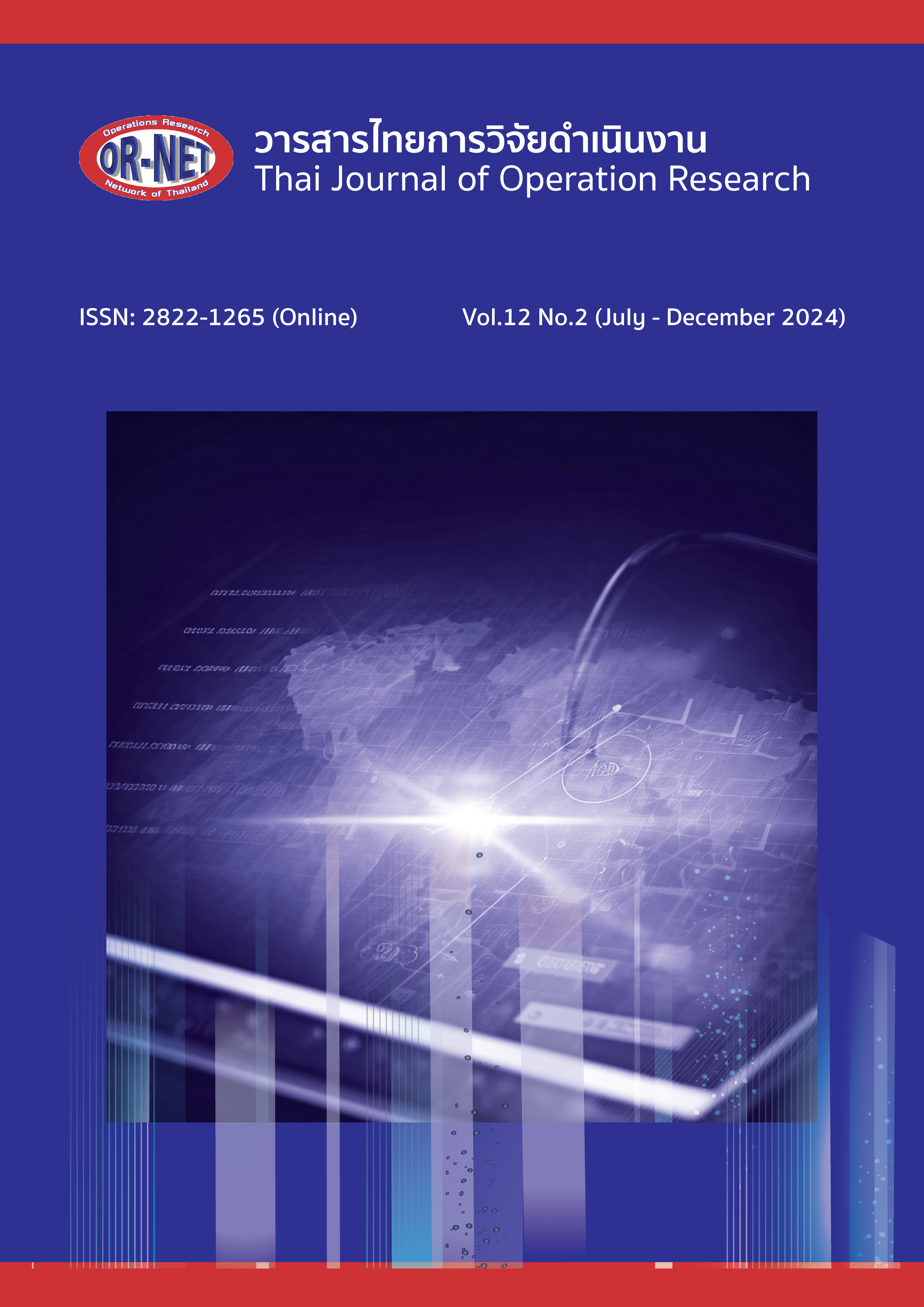การพยากรณ์ปริมาณน้ำที่ไหลเข้าอ่างเก็บน้ำเขื่อนขนาดใหญ่รายเดือน ในภาคตะวันออกของประเทศไทย โดยการค้นหาค่าเหมาะที่สุดแบบนกกาเหว่าปรับปรุงเทคนิค การแยกส่วนประกอบและโฮลต์-วินเทอร์
คำสำคัญ:
การพยากรณ์, อ่างเก็บน้ำเขื่อน, ค้นหาค่าเหมาะที่สุดแบบนกกาเหว่า, แยกส่วนประกอบ, โฮลต์-วินเทอร์บทคัดย่อ
การศึกษานี้มีจุดประสงค์เพื่อประเมินประสิทธิภาพของตัวแบบ จากการผสานการค้นหาค่าเหมาะที่สุดแบบนกกาเหว่ากับโฮลต์-วินเทอร์ (CS-HW) และค้นหาค่าเหมาะที่สุดแบบนกกาเหว่ากับการแยกส่วนประกอบ (CS-D) ในการพยากรณ์ปริมาณน้ำที่ไหลเข้าอ่างเก็บน้ำเขื่อนขนาดใหญ่รายเดือนในภาคตะวันออกของประเทศไทยทั้งหมดจำนวน 6 เขื่อน เมื่อเทียบกับตัวแบบ ค้นหาแบบกริดของโฮลต์-วินเทอร์ (Grid-HW) และแยกส่วนประกอบแบบคลาสสิก (Classic-D) โดยใช้ชุดข้อมูลฝึกฝนจำนวน 66 เดือน และใช้เกณฑ์ค่าน้อยที่สุดของความคลาดเคลื่อนสมบูรณ์เฉลี่ย (MAE) เพื่อประเมินประสิทธิภาพของตัวแบบ ผลการศึกษาพบว่า CS-D และ CS-HW มีประสิทธิภาพสูงกว่า โดย CS-D แสดงค่า MAE ที่ต่ำกว่า Classic-D อย่างชัดเจน ในขณะที่ CS-HW มีค่า MAE ทีต่ำกว่า Grid-HW อยู่เล็กน้อยในทุกเขื่อน
ในการพยากรณ์ปริมาณน้ำที่ไหลเข้าอ่างเก็บน้ำเขื่อนล่วงหน้าในระยะยาว 24 เดือน จากชุดข้อมูลทดสอบ ใช้เกณฑ์รากของค่าคลาดเคลื่อนกำลังสองเฉลี่ย (RMSE) MAE และร้อยละความคลาดเคลื่อนสัมบูรณ์เฉลี่ยแบบสมมาตร (sMAPE) เป็นเครื่องมือในการประเมินประสิทธิภาพของตัวแบบ ผลการศึกษาพบว่า เขื่อนขุนด่านปราการชลเลือกตัวแบบค้นหาค่าเหมาะที่สุดแบบนกกาเหว่ากับโฮลต์-วินเทอร์รูปแบบบวก (CS-HW+) เขื่อนคลองสียัดเลือกตัวแบบค้นหาค่าเหมาะที่สุดแบบนกกาเหว่ากับโฮลต์-วินเทอร์รูปแบบคูณ (CS-HWx) เขื่อนนฤบดินทร์จินดาเลือกตัวแบบ Box-Jenkins เขื่อนบางพระเลือกตัวแบบค้นหาค่าเหมาะที่สุดแบบนกกาเหว่ากับการแยกส่วนประกอบรูปแบบคูณ (CS-Dx) เขื่อนประแสร์เลือกตัวแบบค้นหาแบบกริดของโฮลต์-วินเทอร์รูปแบบคูณ (Grid-HWx) และหนองปลาไหลเลือกตัวแบบค้นหาแบบกริดของโฮลต์-วินเทอร์รูปแบบบวก (Grid-HW+) โดยการพยากรณ์ล่วงหน้า 24 เดือน แสดงให้เห็นว่าปริมาณน้ำที่ไหลเข้าอ่างเก็บน้ำเขื่อนมีฤดูกาลชัดเจน
เอกสารอ้างอิง
M. Dorigo, “Optimization, learning and natural algorithms,” Ph.D. thesis, Politecnico di Milano, Italy, 1992.
M. Dorigo, M. Birattari and T. Stutzle, “Ant colony optimization,” IEEE Comput Intell., vol. 1, no. 4, pp. 28–39, 2006.
J. Kennedy and R. Eberhart, “Particle Swarm Optimization,” in Proceedings of the 1995 IEEE International Conference on Neural Networks, Perth, WA, Australia, pp. 1942–1948, 1995.
H. A. Abbass, “MBO: Marriage in Honey Bees Optimization – a Haplometrosis Polygynous Swarming Approach,” in Proceedings of The 2001 Congress on Evolutionary Computation, Seoul, Korea (South), pp. 207–214, 2001.
X. Li, “A new intelligent optimization-artificial fish swarm algorithm,” PhD thesis, Zhejiang University of Zhejiang, China, 2003.
R. Martin and W. Stephen, “Termite: A Swarm Intelligent Routing Algorithm for Mobilewireless Ad-Hoc Networks,” in Stigmergic Optimization, Studies in Computational Intelligence, Springer, Berlin, Heidelberg, 2006, pp. 155–184.
B. Basturk and D. Karaboga, “An Artificial Bee Colony (ABC) Algorithm for Numeric Function Optimization,” in Proceedings of the IEEE Swarm Intelligence Symposium, Indianapolis, USA, pp. 12–14, 2006.
P. C. Pinto, T. A. Runkler and J.M. Sousa, “Wasp Swarm Algorithm for Dynamic MAXSAT problems,” in Adaptive and Natural Computing Algorithms, Springer, Berlin, Heidelberg, 2007, pp. 350–357.
A. Mucherino and O. Seref, “Monkey Search: A Novel Metaheuristic Search for Global Optimization,” in AIP Conference on Data Mining, Systems Analysis and Optimization in Biomedicine, Gainesville, 2007.
C. Yang, X. Tu and J. Chen, Algorithm of Marriage in Honey Bees Optimization Based on The Wolf Pack Search, in Proceedings of The 2007 International Conference on Intelligent Pervasive Computing (IPC 2007), Jeju, Korea (South), pp. 462–467, 2007.
X. Lu and Y. Zhou, “A Novel Global Convergence Algorithm: Bee Collecting Pollen Algorithm, in Advanced Intelligent Computing Theories and Applications With Aspects of Artificial Intelligence, Springer, Berlin, Heidelberg, 2008, pp. 518–525.
Y. Shiqin, J. Jianjun and Y. Guangxing, “A Dolphin Partner Optimization,” in Proceedings Of The WRI Global Congress on Intelligent Systems, Xiamen, China, pp. 124–128, 2009.
X. S. Yang and S. Deb, “Cuckoo Search Via Lévy Flights,” in Proceedings of The World Congress on Nature & Biologically Inspired Computing (NaBIC), Coimbatore, India, pp. 210–214, 2009.
J. Sun, B. Feng and W. Xu, “Particle Swarm Optimization With Particles Having Quantum Behavior,” in Proceedings of the 2004 Congress on Evolutionary Computation (IEEE Cat. No.04TH8753), Portland, OR, USA. pp. 325-331, 2004.
C. T. Cheng, W. J. Niu, Z. K. Feng, J. J. Shen and K. W. Chau, “Daily reservoir runoff forecasting method using artificial neural network based on quantum-behaved particle swarm optimization,” Water., vol. 7, no. 8, pp. 4232-4246, 2015.
W. J. Niu, Z. K. Feng, C. T. Cheng and J. Z. Zhou, “Forecasting daily runoff by extreme learning machine based on quantum-behaved particle swarm optimization,” Journal of Hydrologic Engineering., vol. 23, no. 3, pp. 04018002, 2018.
Z. K. Feng, W. J. Niu, Z. Y. Tang, Z. Q. Jiang, Y. Xu, Y. Liu and H. R. Zhang, “Monthly runoff time series prediction by variational mode decomposition and support vector machine based on quantum-behaved particle swarm optimization,” Journal of Hydrology., vol. 583, no. 6, pp. 1-12, 2020.
E. Hadavandi, A. Ghanbari and S. Abbasian-Naghneh, “Developing a Time Series Model Based on Particle Swarm Optimization for Gold Price Forecasting,” in Third International Conference on Business Intelligence and Financial Engineering, Hong Kong, China. pp. 337-340, 2010.
S. Kaewpaengjuntra, S. Somhom and L. Saenchan, “Electricity consumption forecasting model using hybrid Holt-Winters exponential smoothing and artificial bee colony algorithm,” Information Technology Journal., vol. 6, no. 1, pp. 12-17, 2010.
M. V. O. Assis, L. F. Carvalho, J. J. P. C. Rodrigues and M.L. Provençal, “Holt-Winters Statistical Forecasting and ACO Metaheuristic for Traffic Characterization,” in Proceeding of 2013 IEEE International Conference on Communications (ICC), Budapest, Hungary, pp. 2524-2528. 2013.
A. Simoni, E. D. Gjika and L. Puka, “Evolutionary Algorithm PSO and Holt-Winters Method Applied in Hydro Power Plants Optimization,” in Proceeding of the SPNA -Statistics Probability and Numerical Analysis, Tirana, Albania, pp. 7-20, 2015.
W. Minsan and P. Minsan, “Incorporating decomposition and the Holt-Winters method into the whale optimization algorithm for forecasting monthly government revenue in Thailand,” Science & Technology Asia., vol. 28, no. 4, pp. 38-53, 2023.
W. Minsan and P. Minsan, “Decomposition and Holt-Winters enhanced by the whale optimization algorithm for forecasting the amount of water inflow into the large dam reservoirs in southern Thailand,” Journal of Current Science and Technology., vol. 14, no. 2, pp. 1-16, 2024.
C. C. Mauricio and C. F. Ostia, “Cuckoo Search Algorithm Optimization of Holt-Winter Method for Distribution Transformer Load Forecasting,” in Proceeding of the 2023 9th International Conference on Control, Automation and Robotics (ICCAR), Beijing, China, pp. 36-42, 2023.
X. S. Yang, Nature-Inspired Optimization Algorithms, London: Elsevier, 2014.
R. N. Mantegna, “Fast, accurate algorithm for numerical simulation of Lévy stable stochastic process,” Phys Rev E., vol. 49, no. 5, pp. 4677-4683, 1994.
Royal Irrigation Department, Ministry of Agriculture and Cooperatives, “Reservoirs Nationwide,” [Online]. Available: https://app.rid.go.th/reservoir/rsvmiddle. [Accessed 26 January 2024].
R. J. Hyndman and A. B. Koehler, “Another look at measures of forecast accuracy,” International Journal of Forecasting., vol. 22, no. 4, pp. 679-688, 2006.
G. E. P. Box, G. M. Jenkins, G. C. Reinsel and G. M. Ljung, Time Series Analysis: Forecasting and Control, 5th ed., Oxford, England: John Wiley & Sons, 2015.
S. Hochreiter and J. Schmidhuber, “Long short-term memory,” Neural Computation., vol. 9, no. 8, pp. 1735-1780, 1997.
“Google Colab, Overview of Colaboratory Features,” [Online]. Available: https://colab.research.google.com/notebooks/intro.ipynb. [Accessed 1 February 2024].
ดาวน์โหลด
เผยแพร่แล้ว
รูปแบบการอ้างอิง
ฉบับ
ประเภทบทความ
สัญญาอนุญาต

อนุญาตภายใต้เงื่อนไข Creative Commons Attribution-NonCommercial-NoDerivatives 4.0 International License.




